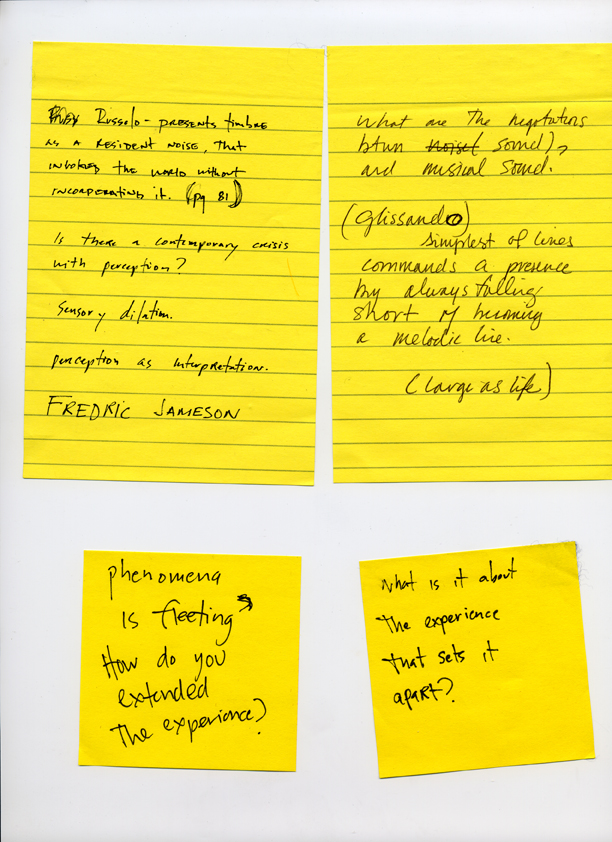31 July 2007
Ah this one is slightly more complicated because of my scan job, but lets go from left to right, upper left hand corner is 1, upper right is 2, lower left 3, lower right 4.
Number 1: Okay, because I am fairly environmentaly conscious, I re-use the hell out of my post-it notes, also I sort of bounce back and forth between two things when I think they are running parellel.
Might as well begin with the Russolo notation. What I thought was noteworthy was the idea of the world without the inclusion of it.
What does that mean, ‘timbre as a resident noise, that invoked the world without incorporating it’? Pearsall and Trumbell define timbre as being ‘the distinctive character of a musical sound or voice apart from its pitch and intensity’ (p. 1509 2003). Timbre is an aspect of sound it’s one element of many that make a particular sound, sound the way it does. Just like in a swatch of red paint, the colour red is made up of a variety of different tones which make it red, timbre is one of those elements in relation to sound.
It’s not so much the idea of timbre, but the idea of invoking the world without incorporating. In March I installed a piece at the McLellan Gallery building in Glasgow. The building is no longer used as an exhibition space, but has a more multi-purpose aspect now that the Glasgow School of Art has temporary use. I installed my sound piece in the foyer area, which spans three floors (to see images, please go to flickr.com search under aps215), the work itself was created from a variety of different processed sounds. In a tutorial with my supervisors there were a lot of questions about the nature of these sounds, ‘were that a jet engines and did I mean to evoke the idea of jet engines per say’. No the sound was not a jet engine, and no I did not mean to evoke that particular response, but that doesn’t make it wrong. There is something inherently metaphorical about sound, if something has an even beat it can reference the heart without even meaning to, so the idea of bringing forth reference to the real world is both interesting and a pain in the ass. Whilst that response is very cheeky, what I mean is regardless of the level of sophistication to create an alternative universe; you still leave and enter the experience through the real world. The more thinking I do on this, the more success I think can be reached when the lines are blurred and the distinction between what is real and what isn’t can not be recognized, then it’s not a matter of incorporation or invoking.
Within the context sound, what makes that interesting is regardless of how processed and filtered a sound is, there seems to be something to anchor it to some aspect of reality. Theoretically I am ok with this, in fact I am more than ok with it, but on some other level the metaphorical nature of noise as sound and noise that exists in the world is frustrating. I want to create my sound work from sounds and or noises that come from outside of myself (the real world), but that doesn’t mean they are what they sound like, nor should that reference be the first you make, but to achieve that, our brains need to be rewired to think outside of preconceived contexts.
So yeah, now going back an analyzing my notes the question ‘Is there a contemporary crisis with perception?’ I am not sure I know what a contemporary crisis with perception means, nor am I attributing at this stage the question with Fredric Jameson, but in hindsight the quote fits the aforementioned really well.
Whilst I was closing the gap in my knowledge about sound, I was also doing a lot of thinking about perception because I was/am/continually forming a contextual standpoint for the research and my practice, so the notations about perception are dealing with the formation of those thoughts. (this will continually be revisited).
Number 2: What are the negotiations btwn noise (crossed out) (sound) and musical sound? I was still unsure of where I sat on the noise/sound/music front, and so was asking a lot of questions of where my work is situated. Now with benefit of year plus’s worth of knowledge I would have to say noise should not be scored out in favour of the word sound, and that the negations are born out of the academy’s desire to define, in practice or at least my practice it’s not as big a concern (personal statement). I make noise I make music: whatever.
Numbers 3 and 4: I got in the habit or rather I am in the habit of writing down the thing that comes to me, at the moment it does. Often I forget to contextualize it, thus making it seem random. These questions and or statements, ‘What is it about the experience that sets it apart?, and ‘phenomena is fleeting. How do you extend the experience?’ reference my own practice and the creation of work within the greater context of ‘phenomenological art’ (i.e. James Turrell, Robert Irwin, and William Basinski). My personal experiences with work created by these guys has been everlasting and extremely important to my practice, and I was asking those questions of my work in relation to their work because I feel that someone like Irwin’s installations do extend the experience. It doesn’t end when you leave the gallery it sticks with you, how do you do that?








